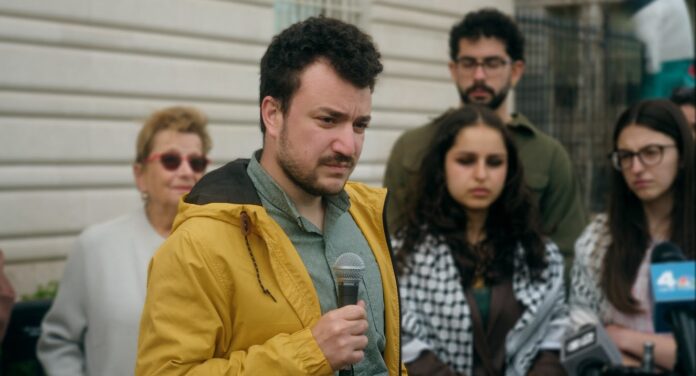At a time of unprecedented effort to dismantle U.S. institutions and erase whole swaths of our history, you could make a case for the idea that no single artist has created a more valuable record of those things than the still-active (at 95!) veteran documentarian whose seven decades of work get a retrospective at the Roxie Theater starting this week. The features in This Is America: Frederick Wiseman—7 Dispatches (Wed/2-June 12) constitute just a small fraction of his output over that span. But each is a world unto itself, an attempt at an all-encompassing, multi-leveled view of some complicated entity serving the public in one way or another.
The series begins Wed/2 with 1980’s Model, one of his looks at a particular industry—this one inevitably stripping the glamour from a profession identified with little else. But his career began in earnest with the next program, 1967 directorial debut Titicut Follies (Sun/6). Setting a template for what was to come, it eschewed all the stock nonfiction explanatory devices of voiceover narration, onscreen text, interviews, etc. for straight-up observation of everyday life in Bridgewater, Massachusetts’ State Prison for the Criminally Insane. While its officials agreed in advance to his methods, they were so shocked at the unflattering results that the state government succeeded in getting the film basically banned from exhibition for a quarter century. Nonetheless, its portrait of primitive, sometimes abusive conditions visited upon the mentally ill had a reforming impact on many such asylums. (Unfortunately, theoretical plans to replace such “looney bins” with extensive community care programs were never a priority from Nixon onward… one big reason that we now live in a United States in which “crazy homeless people” have nowhere to go, let alone systems to monitor and encourage their wellness.)
Equally eye-opening to many were Wiseman’s more widely seen next films, the self-explanatory High School (1968), the next year’s Law and Order (about the Kansas City Police Department), or Hospital, which plays on May 17. The latter in particular captured a the mix of professional empathy, exhaustion, and bureaucracy propping up a big-city healthcare facility, NYC’s Metropolitan. Five years later, 1975’s Welfare (which closes the series on June 12) provided a similar view in which government employees and claimants who often appeared at exasperating odds with each other nonetheless both seemed weary combatants against a system of Byzantine complexity. At nearly three hours, it also kept pushing the scale and detail-density of his examinations.
Other, lesser-known films in the lineup demonstrate the diversity of Wiseman’s subjects, encompassing dissection of a famous resort town (1991’s Aspen, playing April 12), an international transit point of particular current political interest (1977’s Panama-shot Canal Zone, May 3), and a school for the hearing impaired (1986’s Deaf, June 7). Later on Wiseman did a number of movies about cultural landmarks, including some overseas (including London’s National Gallery and the Paris Opera Ballet), plus more governmental apparatuses: Public Housing, State Legislature, Missile. It’s a huge ouevre that constitutes a massive gift of historical insight to viewers in the future—precarious as that future may look at present. Bay Area-based filmmaker, distributor, and Wiseman authority Arlin Golden will introduce each film in the series, which full program can be found here.
Though his films have sometimes had the impact of exposes, spurring institutional change, Wiseman has never made overtly activist cinema—a big part of the documentary form since he emerged in the mid-late 1960s. Upholding that separate tradition is Michael T. Workman and Kei Pritsker’s new The Encampments, which opens at the Roxie this Fri/4. It is unabashedly partisan in taking the side of students protesting Columbia University’s ties to pro-Israel interests amidst the post-Oct. 7 Gaza war—the school’s $14 billion endowment includes investments in weapons industries and information technologies that support the occupation of Palestinian lands. Previous calls for divestment (re: private prisons, Russian holdings after the invasion of Ukraine, etc.) had been successful. But the university was much more resistant on this matter, presumably from fear of offending much of its donor base.
Stonewalled, student activists established a tent camp on campus as ongoing protest. The administration’s response was to arbitrarily change its own rules regarding campus activism, threaten participants with suspension, give NYPD officers free rein, and stand aside when masked, armed Zionist counterprotestors showed up one night to rough up peaceful demonstrators. Meanwhile we see Columbia officials, conservative politicians and media personnel simplistically reduce the issues to “anti-Semitism” from “brainwashed, virtue-signaling” students “taken over by radical ideology” because they saw “something on TikTok” but “have no idea what they’re talking about.” Never mind that these youth are probably better informed about the current crises in Gaza than 99.9% of Americans.
Featuring some hard-to-watch footage of what is actually happening in that distant locale, The Encampments makes for infuriating viewing—even though there’s a flicker of triumph as the crackdown at Columbia has a domino effect in spurring similar protests around the country and world. These 81 minutes witness “free speech” dying onscreen. One of the main protagonists is Palestinian grad student Mahmoud Khalil, whom you might be aware (as a postscript notes) was arrested by ICE in his dorm earlier this month. He was charged with no crime but threatened with deportation nonetheless, despite being a permanent legal U.S. resident. While no one here applauds Hamas’ terrorist acts, they are clear in saying those acts do not justify settler colonialism or Palestinian displacement, let alone genocide. This very well-crafted movie makes a strong case for that side. If you want the other side, Will & Grace star Debra Messing produced the recently released October 8, which argues that all criticism of Israeli governmental and military policy is, you guessed it, just anti-Semitism.
On a somewhat lighter note, three new documentaries showcase major talents and trends from the last few decades in popular music. Varda Bar-Kar’s Janis Ian: Breaking Silence provides a first-person autobiographical overview of a singer-songwriter whose career began precociously on the folk revival stages of Greenwich Village. At 13 she wrote “Society’s Child,” a song about interracial love that made DJs so nervous she was 15 by the time it got some airplay in 1967, boosted by endorsement from no less than Leonard Bernstein. Too much fame too soon caused a druggy mental-health spinout by decade’s end. But she rebounded as a mature artist in the Me Decade with the widely covered “Stars” and signature personal hit “At Seventeen.”
Narrating her own story, Ian takes herself just as seriously as the movie does. That can make for a long two hours at times—she has a lot of scores to settle, and after a while you lose count of how many people she felt victimized by. Breaking Silence (a title taken from the 1993 album where she came out as bisexual) also feels padded with too much dramatic-reenactment material, never my favorite element in a documentary. Still, it is worthwhile as an imperfect-yet-welcome look at a significant career. The film plays Bay Area theaters including SF’s Opera Plaza Cinemas, Berkeley’s Elmwood, and Marin’s Rafael Film Center for runs of variable length starting Wed/9—for specific locations and dates, go here.
By contrast, Stanley Nelson and Nicole London’s We Want the Funk! seems far from exhaustive—let alone definitive—as it crams an overview of that booty-moving musical genre into just 80 minutes. That allows time for brief focus on superstars like James Brown, Sly Stone, Parliament, Sun Ra, and Prince; digressions into the influences of gospel and northern migration, as well as the creative exchange with African musicians like Fela Kuti. Interviewees include Nona Hendryx, George Clinton, Questlove, and (maybe a little too much) David Byrne. A bit all over the map, achieving little depth of investigation, this “American Masters” documentary nonetheless can hardly fail to delight thanks to plentiful archival footage, much of it derived from Soul Train and the like. It will be shown free at SF’s Presidio Library at 3pm on Tue/1, then premieres on PBS’ Independent Lens Tue/8.
The music business has had room for flamboyant personalities behind the scenes as well as onstage, as proven by the late subject of Alexis Manya Spraic’s The World According to Allee Willis. Estimated to have sold over 60 million records, that Detroit-raised escapee to Los Angeles had her own brief, failed attempt at stardom there in the early 1970s. But she proved an extraordinary successful songwriter for other artists, in myriad genres, writing (or co-writing) hits that ranged from Earth Wind & Fire’s “September” to TV’s Friends theme song, in idioms from soul to pop to New Wave… plus the Broadway musical The Color Purple. She was also reportedly one of the world’s greatest (and most frequent) party givers, her San Fernando Valley home being itself a wonderland of kitsch collectibles. This fun tribute not only illustrates a singular career, but draws on testimonies from friends and collaborators including Mark Mothersbaugh, Cyndi Lauper, Patti Labelle, and the Pet Shop Boys. It begins streaming on Hulu Sat/5.




